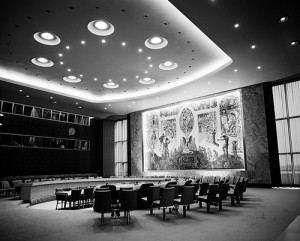State Violence and the Responsibility to Protect: the role of the international community – Tiffany Jeffery
Genocide, war crimes, ethnic cleansing, and crimes against humanity; these four issues are arguably the four most central problems present in the humanitarian world. Together they have led to a collective international agreement accepted by the United Nations Member States: the Outcome Document of the 2005 World Summit, in the hope of preventing mass atrocities. On Tuesday November 15th 2011, the London School of Economics and Political Science (LSE), hosted an event to examine and discuss the manner in which the Responsibility to Protect, or R2P, was agreed upon at the United Nations General Assembly in 2005, the implementation of R2P at an international level, and the future challenges of the concept of R2P.
The lecture, titled; ‘State violence and the Responsibility to Protect: the role of the international community’ was given by Sir Adam Roberts president of the British Academy and Professor of International Relation at Oxford University, Ignacio Llanos, Counsellor of the Embassy of Chile in the United Kingdom, Dr Chaloka Beyani, senior lecturer in Law at LSE and UN special rapporteur on the Human Rights or Internally Displaced Persons. The diverse backgrounds of each of the three speakers, ranging from the first hand experience of Ignacio Llanos to the academic perspective of Sir Adam Roberts, provided for a dynamic and informative lecture. Each speaker offered an extensive, as well as, distinctive analysis on the theory of R2P in an attempt to conceptualize this term within the broader context of today’s political realities.
First to speak was Sir Adam Roberts, who focused his argument on the inherent hazards of the Responsibility to Protect and the language used to discuss the subject. Sir Adam Roberts’s argument centered on the idea that, contrary to popular understanding; R2P is not a new principle. Sir Adam Roberts stressed that he was nervous about the fact that people think of R2P as a recent concept (it actually emerged sometime in the last 20 years), as it implies that, up until around 20 years ago “the world consisted of states pursuing national interests and operating on the Westphalian principle of sovereignty and respect for states, and then now, in the progressive era, where human rights are on the international statute books, we have reached a higher level of international morality, where people and security of people enters in, and in some cases, even takes precedent on the security of states”; believing this thought to be an oversimplification of the past.
Sir Adam Roberts, suggests a “Long and tangled history of R2P,” pointing to the case of the Indian invasion of Pakistan in 1971 and the creation of Bangladesh, as a situation where intervention (as is suggested in the doctrine of R2P) helped to address a serious humanitarian problem. He carries on his argument for the pre-existence of R2P by highlighting the fact that the United Nations Security Council already had the right to state intervention. Roberts goes on to say that the creation of an international agreement specifying the responsibility to protect has merely increased the pressure for states to intervene. Sir Adam Roberts concludes his argument by stating that R2P is now often seen as an attempt by states to extend their powers through ‘humanitarian intervention’ rendering its application on both a political and legal basis, difficult, urging us to re-evaluate the language of R2P.

UN Security Council Chamber - Credit: UN Photo
Ignacio Llanos, who was second to speak, took a very different approach to R2P than that of Sir Adam Roberts. Llanos suggests that the Responsibility to Protect, is one of the most important achievements in the realm of international law, focusing his argument on the content found within the 2005 UN agreement and highlighting the inherent problems with its application at the level of the UN Security Council. The element of R2P, which Llanos asserts is its most fundamental flaw, is its application within the UN Security Council.
The use of R2P must be approved by the Security Council; this becomes problematic as the states which are members of the Security Council have retained the right to veto, even in matters concerning state intervention and issues involving the Responsibility to Protect. Llanos disputes that the veto makes the doctrine of R2P incomplete. Llanos, argues that the use of the veto on matters of R2P should be restricted, as it challenges the legitimacy of international law.
The Responsibility to Protect can be triggered by four crimes; genocide, war crimes, ethnic cleansing, and crimes against humanity. These crimes are prohibited by international law, with the exception of ethnic cleansing (which could constitute one of the other three crimes), and have been codified in the statute of the International Criminal Court. As a result, Llanos argues that the legitimacy of the UN Security Council, R2P, and international law are all challenged by the use of the veto on matters concerning R2P. Ignacio Llanos, advocates a restriction of the use of the veto on R2P and highlights a new view of ‘Sovereignty as Responsibility’ which implies a diminished role of state. Llanos encourages the use of force as a last resort claiming that R2P can be a powerful tool in international law.
Dr Chaloka Beyani was the final presenter and he, like Sir Adam Roberts, took a critical approach to the implementation of Responsibility to Protect. Beyani’s problem with the concept is the manner in which the international community has conceptualized it. Beyani believes that R2P has had minimal success on a legal basis within the African Union, but that on the whole, R2P has failed to accomplish the original intention set out in 2005; stating that through it, “we do not see the protection of civilians in action.” Beyani argues that there has only been a marginal implementation of R2P and that the contextual elements of the theory have been ignored with too much focus being placed on its practical aspects. Beyani considers the primary role to be on the states and places a secondary role on the international community, believing that R2P should be institutionalized and implemented in cases such as Lybia and the Ivory Coast.
In conclusion, Responsibility to Protect has slowly diverged from its original purpose to become an inconsistent theory. If we consider the arguments that have been advanced by both Sir Adam Roberts and Dr Chaloka Beyani, we would be encouraged to reconsider the use of the term Responsibility to Protect. If the international community were capable of re-evaluating the application of R2P and creating more consistent international laws for its application, it may be possible for the concept to become something which more closely resembles Ignacio Llanos’ optimistic view of R2P as a powerful tool in international law.
A podcast of this event is available via LSE Public Events.
Tiffany Jeffery is an LLB1 student at The City Law School.

